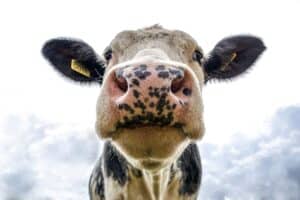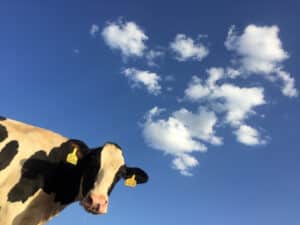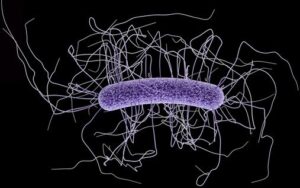Flies aren’t just an annoyance to livestock, left untreated, these pests can cost producers substantial economic losses in performance and health issues every year. Discomfort caused by flies leads to behavior changes such as constant head-tossing, stomping and overall restlessness of animals which can result in reduced grazing, weight loss and other negative impacts on livestock performance. Additionally, flies are vectors for livestock disease such as keratoconjunctivitis (pinkeye) and summer mastitis.
Types of Flies

There are three main types of flies that affect beef cattle: horn flies, stable flies, and face flies.
Horn Flies
Horn flies look like house flies but are about half the size. They are blood-feeding insects that are often found on the backs, sides, and poll area of cattle. They are difficult to control and in high populations can be detrimental to performance. Each horn fly has between 20-30 blood meals per day and can have negative effects on skin health and blood and energy losses. Research shows that when fly counts reach 200 flies per animal, the economic threshold has been reached and animals will have significant weight loss. The pain and stress from constant biting can reduce cattle weight gains by as much as 20 pounds.
Stable Flies
Stable flies are found on almost every livestock species. These flies bite on the abdomen, sides, back and legs and cause increased stomping and kicking. What’s unique about stable flies is they only feed during the heat of the day and will rest in shaded areas.
Face Flies
Face flies look like large house flies. They are non-biting flies that feed on the secretions around the eyes and nose, and they are a major vector of pinkeye infection in cattle. Unlike horn and stable flies, face flies are not blood feeding insects, but the spongy mouth parts are highly abrasive.
House Flies
House flies are one of the most common pests and while annoying, they are not a major factor in disease spread in livestock populations. Adults feed on available blood, sweat, tears, saliva and other bodily fluids.
Fly Control
Several forms of fly control are available to livestock producers, including insecticides in spray or tag form, insect growth regulators in feed or supplements, and all-natural insect repellent options such as garlic. Numerous research studies have been conducted with garlic. Livestock specialists in Saskatchewan evaluated the effects of garlic in a mineral supplement for beef cows and reported 52 and 56% fewer flies compared to two control groups. The cattle consume the garlic which omits an odor through the skin and breath, repelling the flies. Once cattle consume mineral containing garlic there is a reduction in fly population within 24 hrs.


Suthers Solutions 20G is a proprietary blend of concentrated garlic extracts and other allium compounds specifically formulated to enhance the flavor of animal feed while acting as an insect repelling agent. This blend is formulated for the feed industry and its consistent, homogenous particle size flows effectively in automated feed systems, making it an excellent choice for feed manufacturers. Furthermore, since 20G is one of the most highly concentrated forms of garlic oil extracts on the market, it requires minimal space in supplements and finished feed. Compared to other insect growth regulators, 20G is an all-natural product that will cost about 60% less.
John R. Jaeger, Beef Cattle Scientist at KSU Western Kansas Research – Extension Center comments: “We use Suthers Solutions 20G in our summer and fall mineral programs. The 20G does an excellent job of repelling flies and eliminating ticks while encouraging consistent mineral intake. We plan to continue using Suthers Solutions 20G as part of our pest management plan. It is an excellent product.”
Flies can have a negative impact on the productivity and profitability of your beef herd. Taking preventative measures to control flies will help ensure that your herd stays healthy and disease free.



